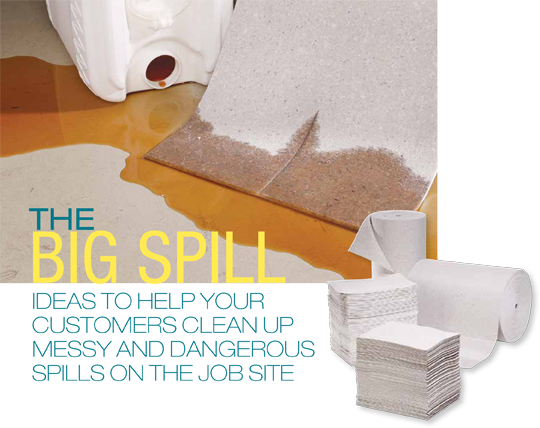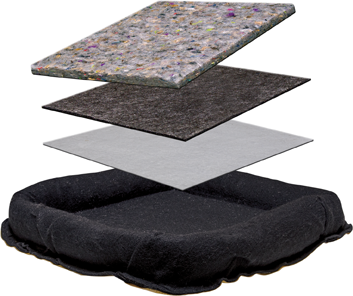The big spill

by Rich Vurva
Leaks and spills of coolant, oils, solvents and even water can cause a dangerous work environment. A variety of spill control options on the market today give customers plenty of choices for their application. Here are a few suggestions from suppliers.
SpillTech
“Everything we do is application driven. So as manufacturing and processing changes, so must we,” says Robin Thornett, marketing manager for SpillTech. “That means new sizes, new absorbencies, new add-on benefits specific to certain struggles that comes with expanding and changing. Where a regular pad or sock might have worked perfectly before, a new design or new process could mean that now that pad needs to stick to the floor or it needs to absorb more (or less!).”
Thornett says the best course of action is to stay as embedded with end users as possible, to understand their needs. “If we can get eyes on the area of concerns, identify issues and talk with workers who do their jobs in those areas, we can make the most effective solution to their problem, before it becomes a problem.
“Following the needs of those applications has resulted in some really cool products, like our new Maximizer line that sops up an amazing 14 times its own weight for those folks with big needs,” she says.
SpillTech’s Maximizer line of absorbents featuring SmartSorb Technology are specifically designed for large spills and high-volume leaks.
SmartSorb Technology creates a mat that absorbs evenly throughout for superior liquid retention. With this technology, Maximizer absorbents provide the highest absorbency for everyday applications, taking in up to 14 times their own weight in liquids, the company says. Available in perforated pads and rolls, Maximizer absorbents will absorb oils, coolants, solvents and water.
Utilizing 75 percent recycled fibers, Maximizer is a great choice when environmentally friendly products are desired, Thornett adds.
Thornetts says that the Contractor Grade line is designed specifically for those who need to get in, wipe up a problem and get out without wasting product or money.
What new technologies and materials are being introduced to improve productivity, durability, etc.?
“There is a certain amount of ‘if it ain’t broke, don’t fix it’ mentality out there, but we continue to see people move away from old methods, such as loose absorbents, to more proven time- and money-savers like polypropylene. It has become about getting the job done efficiently and effectively and getting back to work. So for us, it’s more about refining what we are working with to get the biggest benefit for the end user. For example, we heard from end users about a sinking boom that was costing customers time and money to change out, so we introduced our Premium Boom to answer that problem specifically. Ours is engineered to be more UV resistant and is guaranteed to never sink.”
Meltblown Technologies The most significant trend in the spill control market today is centered around combining productivity, waste reduction and compliance, according to Derek Yurgaitis, president of Meltblown Technologies (MBT). “Traditionally, a consumer would need one or two different categories of products, such as absorbents and secondary containment, in order to meet compliance needs in many situations. Spill control manufacturers are being driven by users to find ways to combine these two categories into effective solutions that save time, reduce waste and increase compliance with OSHA and EPA regulations,” he says.
The most significant trend in the spill control market today is centered around combining productivity, waste reduction and compliance, according to Derek Yurgaitis, president of Meltblown Technologies (MBT). “Traditionally, a consumer would need one or two different categories of products, such as absorbents and secondary containment, in order to meet compliance needs in many situations. Spill control manufacturers are being driven by users to find ways to combine these two categories into effective solutions that save time, reduce waste and increase compliance with OSHA and EPA regulations,” he says.
Yurgaitis says MBT identified this need several years ago and began looking for solutions and materials that were beyond the company’s scope of expertise. “We found that what the market was really looking for was a way to respond more quickly to spills as well as get material closer to the point of use, whether that be in a vehicle, a remote location or simply strategically located inside a facility,” he says.
A challenge with traditional absorbents is their bulk. In order to locate enough absorbent capacity close enough to a potential spill where it could be deployed quickly, large containers (spill kits) or protected storage areas are required. In 2016, Meltblown Technologies joined forces with a long-time competitor, HalenHardy LLC, which was developing a number of interesting materials that solved a variety of these issues.
“Our new Spilltration line of products resolves these challenges with what we call the Speed & Space products. They are extremely quick to deploy and, in addition to being highly absorbent, can be vacuum packed to save even more space. In fact, the product is so well received our Spillver Bullet won the “Best in Show” award at the 2016 National Safety Congress,” Yurgaitis says.
Yurgaitis adds that MBT spends significant time focused on identifying properties that allow users to do more with less. Often that is a durability issue so that products stay in place longer and reach a higher level of saturation before they need to be replaced. “Recently, we added the concept of high visibility. In many applications, providing employees with a visual warning that a surface might represent a hazard to them is far more important than how much it absorbs. Along those lines we are developing technologies that allow our products to adhere to slick surfaces, adding increased functionality to the product and expanding the markets where they can be deployed. We are moving beyond the factory floor and into areas such as hospitality and retail,” he says.
In the not too distant future, Yurgaitis says improvements will come from digital technology. Apps and smart sorbents will be deployed more efficiently and require less effort on the part of the consumer to monitor and maintain. “We will be able to position them in remote areas to monitor conditions and alert us to potential spills and other hazardous situations. These products will be a true win for the environment and potentially save millions of dollars on clean up and injury related costs. More on that later,” he promises.
This article originally appeared in the Jan./Feb. 2017 issue of Industrial Supply magazine. Copyright 2017, Direct Business Media.











